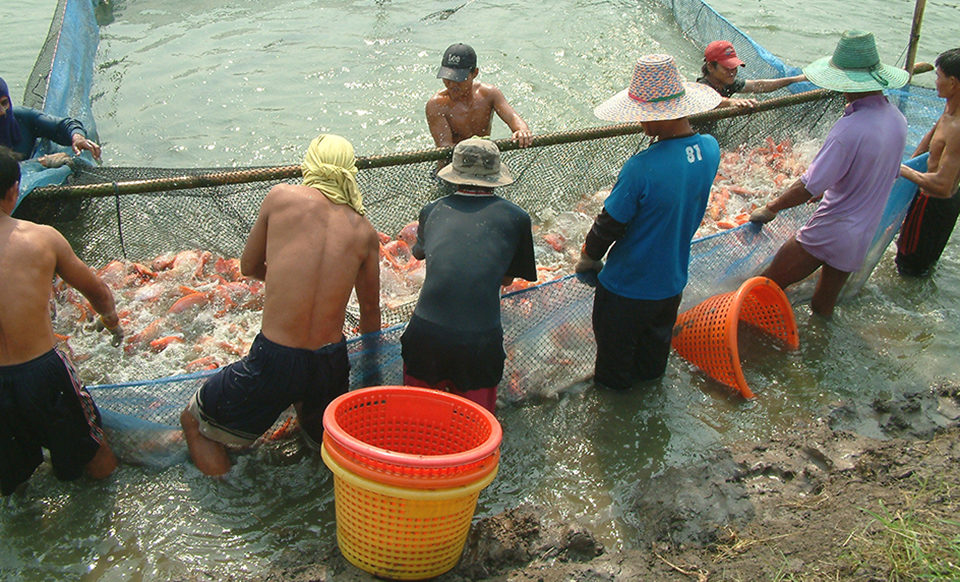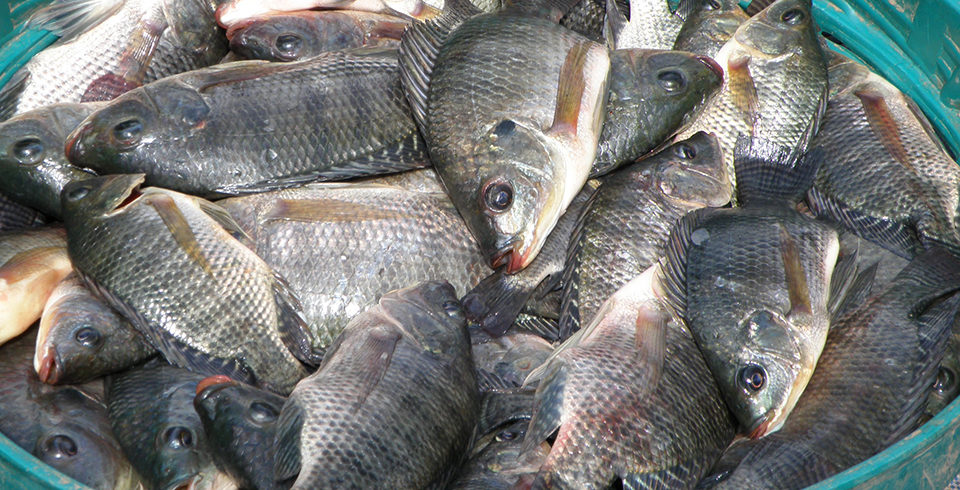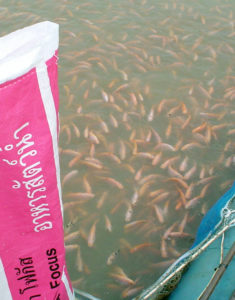Market preferences drive methods, industry integration continues

Tilapia production in Asia largely revolves around the domestic markets, where tilapia is recognized as an inexpensive, nutritious fish that complements Asian cooking styles. Typically, Asian consumers prefer whole fish, live or fresh chilled, and weighing 500 to 700 grams each. The logistics of supplying local wet markets, restaurants and seafood retailers involves a number of steps in the supply chain from farmers and harvesters to brokers and shippers.
By contrast, the international trade in tilapia in Asia has a quite different structure, mainly because the market preference is for either whole frozen fish (gutted and scaled) or fish processed into frozen fillets and other value-added retail products. These products require larger fish, usually 1 kg or heavier.
As a result of these different market preferences, farmers generally tend to focus on one or the other. Which one they choose depends on factors that include farm size, availability of capital, ease of selling and cash flow. In addition, customer concerns about food safety and the advent of demands for farm certification are adding new complexity for farmers, particularly those in the export segment.
These differences are increasing the rate of farm specialization, and there is a growing trend toward integration of the supply chain in the production of tilapia for export. To meet customer demands for traceability, food safety and environmental stewardship, exporters are looking to integrate their supply chains – either by investing in farms or forming partnerships with their farm suppliers. This mirrors the situation in the chicken and other livestock industries, although it is still early in the development process for tilapia.
Integration expands possibilities
The integration of production and exporting presents interesting possibilities, since the key drivers for business success move from purely production performance to adding value through end-product quality. Instead of producing as much fish of the appropriate size as quickly as possible using value-priced feeds with low feed-conversion ratios, it may be more profitable for an integrated business to produce fewer, high-quality fish with premium feeds designed to provide benefits in end-product quality.
Processing plant economics are driven by fillet yield, as each increase in yield results in more profit and less waste. Fillet quality determines what can be processed into value-added and “ready to eat” products. Raw and cooked flesh color, gaping and flesh texture are key indicators used to select fillets for value-added processing. Skin and scale condition can be used to select fish for value-added, skin- and scale-on products such as loins.

Lessons from livestock
Feed producers are challenged to support the needs of two different segments of customers. Customers focused on fillet yield and quality have needs quite different from those domestic producers who simply want a low-cost feed that provides good growth and feed conversion.
Insights from our colleagues who manufacture livestock feeds may offer solutions to these challenges. Though there are differences between fish, pork and poultry, key concepts regarding feed are the same in the three sectors. In many cases, the same or similar solutions can be used.
One of the keys to success is the use of a feeding program in which various elements are employed in sequence to reach the final goal of the customer. By looking at the total production chain and breaking it down into its key elements, it is possible to target nutrition performance to the specific goals of production at each stage.
Strong start
Advantages can be gained through a feeding program that applies targeted technologies to the stages in the production cycle when they are most effective. For example, the goal of production in the early stages is to ensure a good start with fast growth. A number of laboratory and commercial-scale trials have shown that providing high-quality nutrition in the early stages pays dividends, as the initial boost is maintained throughout the production cycle. Even when a high-performance starter feed is later switched to a standard growout feed, the growth is significantly better in the later stages of production.
Since the volume of starter feeds is low relative to total feed use, investing more in this stage can provide an economic advantage over relying on growout and finisher feeds for high performance. Beyond using starter feeds to wean fish onto compound feeds, a good starter feed program can provide a basis for future growth and make it easier for nutritional technologies to manipulate end product characteristics in the finishing phase.
Finishers

There is also opportunity to influence total output or the characteristics of the final product in the later stages of production. The majority of the feed, and therefore cost, is incurred during the final stages of production. Manipulation of end-product quality is an expensive option, as the higher cost of nutrition to alter the final product is amplified by the volume of feed used. Larger fish are also generally less efficient at converting food to flesh than younger fish, further complicating the picture.
The optimal nutritional designs to meet processors’ needs are often different from those that give the most cost-effective growth. For example, nutrient-dense feeds for faster growth and better feed efficiency can result in more body fat in the gut of the fish, reducing fillet yield. On the other hand, feeds targeting value-added impacts such as omega-3 enrichment of fillets may be too expensive for farmers looking for faster growth.
Consumer concerns
Integration of the supply chain for export also has implications for farming practices. Some international consumers have concerns about the sanitary conditions, food safety interventions and environmental impacts of Asian production. There are indications that domestic consumers are also demanding enhanced standards, as witnessed by the expansion into Asia of international supermarket chains that bring their food quality and safety standards to meet increased local expectations.
Perspectives
For now, local markets continue to demand inexpensive, nutritious food for lower-income consumers. The shift to cutting-edge nutrition or enhanced production standards will only occur as demand merits, and traditional forms of production will continue. However, as Asian economies improve and the urban consumer market increases, demand for better products and nutritional solutions will increase.
(Editor’s Note: This article was originally published in the September/October 2009 print edition of the Global Aquaculture Advocate.)
Now that you've finished reading the article ...
… we hope you’ll consider supporting our mission to document the evolution of the global aquaculture industry and share our vast network of contributors’ expansive knowledge every week.
By becoming a Global Seafood Alliance member, you’re ensuring that all of the pre-competitive work we do through member benefits, resources and events can continue. Individual membership costs just $50 a year. GSA individual and corporate members receive complimentary access to a series of GOAL virtual events beginning in April. Join now.
Not a GSA member? Join us.
Authors
-
Dan Fegan
Regional Technical Manager – Aquaculture
Bangkok, Thailand[109,111,99,46,108,108,105,103,114,97,99,64,110,97,103,101,102,95,108,101,105,110,97,100]
-
Daniel Barziza
Cargill’s Innovation Center – Elk River
Minneapolis, Minnesota, USA -
Ryan Lane, Ph.D.
Cargill’s Innovation Center – Elk River
Minneapolis, Minnesota, USA
Tagged With
Related Posts

Health & Welfare
10 paths to low productivity and profitability with tilapia in sub-Saharan Africa
Tilapia culture in sub-Saharan Africa suffers from low productivity and profitability. A comprehensive management approach is needed to address the root causes.

Health & Welfare
A look at tilapia aquaculture in Ghana
Aquaculture in Ghana has overcome its historic fits and starts and is helping to narrow the gap between domestic seafood production and consumption. Production is based on Nile tilapia.

Intelligence
Adding value to tilapia to tap into U.S. market
New markets for tilapia and expansion of existing ones can be created by planning and implementing properly designed geographic strategies to meet discriminating consumer preferences. Low labor costs in most producing countries promotes value-adding by the production of fresh fillets.

Responsibility
Addressing safety in Latin America’s tilapia supply chain
Over the last decade, the experience gained by many tilapia farmers combined with proficient programs implemented by local governments have significantly improved tilapia production in various Latin American countries like Colombia, Mexico, Ecuador and other important tilapia producers in the region.


